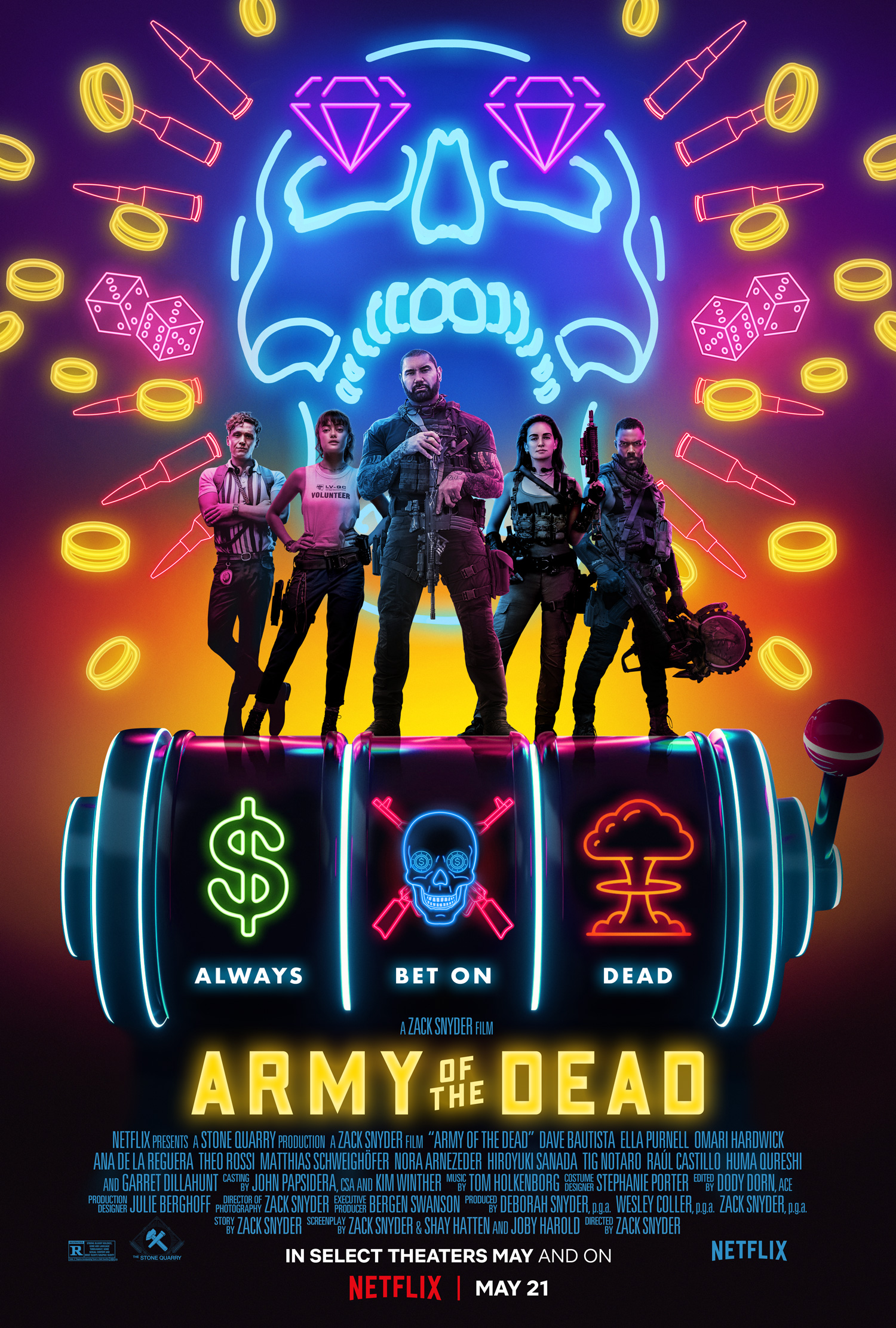
21 May Army of the Dead Review
dir. Zack Snyder, starring Dave Bautista, Ella Purnell, Omari Hardwick, et al
Written, directed, and shot by Snyder, Army of the Dead is at its core an ensemble heist film wrapped in the zombie genre. It’s Snyder’s first entry in his post-superhero phase that was met with mixed results, and I imagine this will be as well. The film starts with a pair of newlyweds, headed out of Vegas and celebrating life in the most Zack Snyder way fashionable. On the opposite route of these lovebirds is a convoy of Army troops carrying an unknown package. These two moving units cross paths, the unknown package is exposed, and we see a flesh eating zombie, who easily dispatches of the troops. From there, told through Snyder’s always incredibly mesmerizing opening credits scene (his greatest strength), we see the fall of Las Vegas due to the zombie invasion, and the city finally walled off from society.
Hired by billionaire Bly Tanaka to sneak into infested Las Vegas to retrieve a vast sum of money from his casino, short order cook Scott Ward assembles a team of various do-no-gooders to get rich. Accompanying them is a man from Tanaka’s crew as well as Ward’s daughter Kate, both with their own motivations. The cast are there for mostly fodder as they’re picked off one by one, some in incredibly gruesome ways, others not as much. A standard zombie movie and a standard heist gone wrong trope, Army of the Dead has little in the way of twists, reveals or surprises. What’s meant to be a bit of a reveal, the nature and composition of the zombies, comes off as clunky and confuses, raising far more questions than it answers. The fact that there’s an animated prequel slated to be produced may clear up some of these answers when seen back to back with this movie, but for now the seeds that are supposed to be planted fall in mostly infertile soil.
What could be the far more interesting story in Army of the Dead are the zombies themselves. We don’t see them often until the third act CGI fest, but what little we do see is both intriguing and and inventive. While the passage of time is unclear between the events of the initial outbreak and Tanaka approaching Ward, in that time the alpha zombie has managed to create a small fiefdom within the walled off city of Vegas. The alpha zombie (which could hardly be considered a tertiary antagonist) also has a mate and is the clear leader of the city. How did this come to be? Were all the other zombies cool with it? Was there a power struggle? Challenges to his leadership? The elements of what wasn’t explored have the potential to be just as interesting as what we were presented with.
Dave Bautista’s continuing quest to be respected as a legitimate actor has been a fascinating watch. A look at his earlier works shows he’s put in his dues, but it wasn’t until the one-two punch of playing Drax the Destroyer and his scant few minutes in Blade Runner 2049 that people really started to take notice of his ability. A hulking man that has the ability to convey nuance and gentleness, Bautista has shown that, when paired with the right director, he’s capable of magic. Sadly, that director does not appear to be Zack Snyder. Here, playing Scott Ward, Bautista turns in an average performance, a step above the Stallone and Schwarzenegger action blockbuster performances of 80s and 90s. As for the rest of the team, Ana de la Reguera as Ward’s right hand woman Maria, gives a great performance with what little material she’s given. Omari Hardwick and Matthias Shchweighofer are a likeable pairing that comes off more as two actors enjoying vibing with each other more than the actual writing. Ella Purnell as Scott’s daughter Kate turns in a serviceable performance and unfortunately Hiroyuki Sanada, one of Japan’s best actors, only appears in a handful of scenes.
Conversely, Tig Notaro and Theo Rossi are downright unwatchable, each for different reasons. Tig’s performance and line delivery are a constant flat line that rarely change in tone or inflection. The fact that Notaro seems to gravitate to roles that are heavy on dry wit and sarcasm are a by product of her life as a beloved standup comedian, but those skills have not served her well on screen as she continues to play an exaggerated version of herself. Rossi, on the other hand, is the largest victim of lazy screenwriting. A flat, one dimensional character that serves no other purpose than to be a toxic presence and cause trouble, Rossi is given less than zero to work with and that lack of material is shown in one of the worst performances of his I’ve seen.
As a director, Zack Snyder is an incredibly polarizing figure. He has an equal measure of die hards and vocal detractors. He’s consistently criticized for his ‘style over substance’ nature and in this case, it would be a fair critique, were it not for frustrating stylistic decisions as well. As Snyder handled the writing, the directing, and the cinematography for the film, there’s noticeable flaws in each. Writing wise, the dialogue is at times stilted and cheesy (easy, peasy, Japanese-y?), especially the scenes written for Theo Rossi’s Burt Cummings, a paper-thin film student antagonist. There’s also a weakness to the writing between Bautista and his daughter Kate as he tries to reconnect with her after years away. The writing is soap operatic, almost a secondhand thought as Snyder was ready to get back to the action. The directing is competent, the Snyder classics are there, if somewhat more diminished than they were in his Justice League film. The speed ramping and excessive slow motion, while present, take a backseat to the frankly mind-boggling decision to shoot most of the movie with a narrow tight focus, leaving much of the background intentionally blurry. When these shots are done with Tig Notaro, who stepped in after the firing of Chris D’Elia, all of her scenes were shot alone, with Notaro being added in with the team in post production. While she’s not seamlessly added into scenes (the differences are fairly obvious), those technical limitations can be forgiven, but this choice to shoot the movie with a strange dream-like quality only detracts from the film. Clocking in at 148 minutes, the movie is also overly long and stretched. Scenes that go on too long (and a few that were completely unnecessary like all of Theo Rossi’s) could’ve had time repurposed to better flesh out our ensemble cast and make us root for the characters that on the surface seem like interesting people. The problem is, the surface is all that’s explored for many.
Overall, as we enter the summer blockbuster season, Army of the Dead is an unfortunate weak kicking off point that does little to explain the world its built or establish most of its characters as people we should care about or root for. Hindered by a bloated run time, questionable character decisions, and frustrating creative choices, the film lands somewhere towards the bottom of Snyder’s oeuvre. As interesting as the concept of a money heist deep into zombie territory can be, the execution of said concept falls short in multiple categories. In the end, Army of the Dead can be added as just one of a million mindless summer blockbusters that have existed throughout the decades, failing to add anything fresh or interesting to the genres. Coming years too late after the country’s obsession with all things zombie has increasingly waned and gave way to superheroes, Snyder seemed better suited to tell stories in the universe of the latter. The movie is best seen on a Friday night, accompanied by friends and a healthy number of drinks. Army of the Dead is on Netflix March 21st.
Review by Darryl Mansel


No Comments